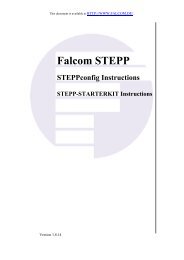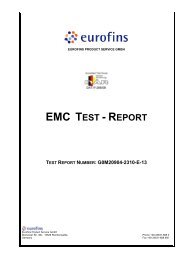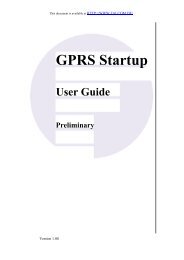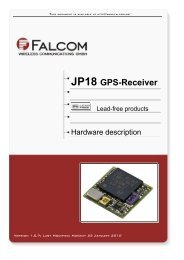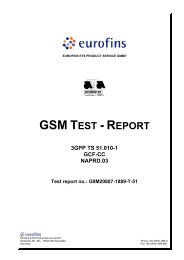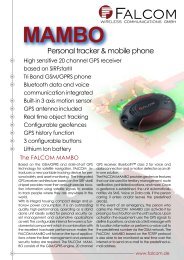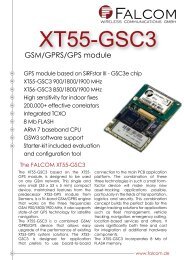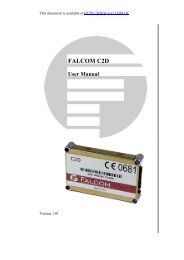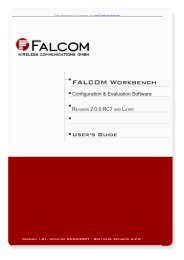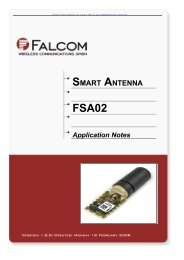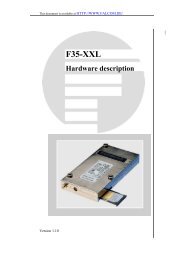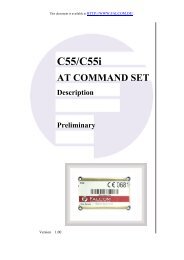steppii-55/56-lt - Falcom
steppii-55/56-lt - Falcom
steppii-55/56-lt - Falcom
Create successful ePaper yourself
Turn your PDF publications into a flip-book with our unique Google optimized e-Paper software.
STEPPII-<strong>55</strong>/<strong>56</strong>-LT HARDWARE DESCRIPTION VERSION 1.01<br />
• the battery is exceeding the critical limits of over or under temperature.<br />
• under vo<strong>lt</strong>age is detected.<br />
The automatic shutdown procedure is equivalent to the power-down initiated, i.e.<br />
STEPPII-<strong>55</strong>/<strong>56</strong>-LT logs off from the network and the software enters a secure state<br />
avoiding loss of data.<br />
6.1.3.1 Over vo<strong>lt</strong>age shutdown<br />
For over vo<strong>lt</strong>age conditions, no hardware and software controlled shutdown is<br />
implemented. If the supply vo<strong>lt</strong>age exceeds the maximum value specified in Table<br />
11, loss of data and even unrecoverable hardware damage can occur.<br />
6.1.4 Charging & Discharging process of the battery<br />
When the battery vo<strong>lt</strong>age reaches 4.2 vo<strong>lt</strong>s per cell, the charging current is<br />
decreased to maintain a constant terminal vo<strong>lt</strong>age of 4.2 vo<strong>lt</strong>s per cell. Charging will<br />
be terminated after the battery reaches full capacity, which approximately takes 5-7<br />
hours. During this time the unit can also be used, but note that, the battery’s<br />
capacity must be higher then 3.8 V.<br />
Keep in mind, the extreme temperatures have an unfavourable influence on the<br />
rechargeable batteries. The capacity and life cycle of the batteries are reduced if<br />
they are kept at cold or warm places, e.g. in a closed car at summer or winter<br />
conditions. Try always to keep the included battery at normal temperatures<br />
between 10°C and 25°C. Outside this range, a decrease in battery performance<br />
may resu<strong>lt</strong>. The terminals STEPPII-<strong>55</strong>/<strong>56</strong>-LT with a too cold or too warm battery does<br />
not temporarily operate sometimes, even if the battery is completely charged.<br />
Especially, the achievement of battery is strongly reduced at temperatures under<br />
the freezing point.<br />
6.2 Automatic GPRS Mu<strong>lt</strong>islot Class change<br />
Temperature control is also effective for operation in GPRS Mu<strong>lt</strong>islot class 10. If the<br />
board temperature exceeds the specified limit (see 4.1.2 for temperature limits<br />
known as restricted operation) while data are transmitted over GPRS, the module<br />
automatically reverts from GPRS Mu<strong>lt</strong>islot class 10 (3 RX x 2 TX) to class 8 (4 RX x 1 TX).<br />
This reduces the power consumption and, consequently, causes the temperature of<br />
board to decrease. Once the temperature drops to a value of 5 degrees below the<br />
limit of restricted operation, STEPPII-<strong>55</strong>/<strong>56</strong>-LT returns to the higher Mu<strong>lt</strong>islot class 10. If<br />
the temperature stays at the critical level or even continues to rise, STEPPII-<strong>55</strong>/<strong>56</strong>-LT<br />
will not switch back to the higher class. After a transition from Mu<strong>lt</strong>islot class 10 to<br />
Mu<strong>lt</strong>islot class 8 a possible switchback to Mu<strong>lt</strong>islot class 10 is blocked for one minute.<br />
Please, note that there is no one single cause of switching over to a lower GPRS<br />
Mu<strong>lt</strong>islot class. Rather it is the resu<strong>lt</strong> of an interaction of several factors, such as the<br />
board temperature that depends largely on the ambient temperature, the<br />
operating mode and the transmit power. Furthermore, take into account that there<br />
is a delay until the network proceeds to a lower or, accordingly, higher Mu<strong>lt</strong>islot<br />
class. The delay time is network dependent. In extreme cases, if it takes too much<br />
time for the network and the temperature cannot drop due to this delay, the<br />
terminal may even switch off.<br />
6.3 Determining the External Equipment Type<br />
Before you connect the serial port pins on the aforementioned terminals (DCE units)<br />
to external equipment, you need to determine if the external hardware serial ports<br />
are configured as DTE or DCE.<br />
This confidential document is a property of FALCOM and may not be copied or circulated without previous permission.<br />
Page 28



